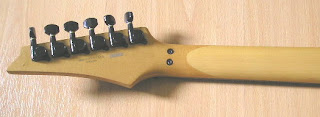



Managed to try Biyang pedals today (Tone Fancier Series):
AD-7 Analog Delay:
- Fundamental 2-mode feature is rather limited but these are the working parameters if you don't fancy excess
- Above-average tonal response, in fact, I'd recommend it together with other affordable no-frills delay out there: Ibanez DE7/ Artec SE-ADL/ Carl Martin Red Repeat
CH-7 Chorus:
- Again, the 2-mode offering isn't for the demanding snob
- Nothing too tingling, it's a mild type chorus with adequate depth to project clarity
- Some of us prefer mild chorus as it doesn't phase/ flange-out at upper intensity settings, especially with overdrive/ distortion
DS-7 Distortion:
- 3 modes: NORMAL- regular fry-type, not intense but more protrusive than the proverbial BOSS DS-1/ BRIGHT- enhancement of upper end frequency the presence of which cannot be comprehensively curbed by the tone control/ WARM- enhancement of lower frequencies akin to what a tamed fuzz unit would churn out without the excessive wooliness
- Impressive tone/ distortion sweep
OD-7 Overdrive
- Surprise: JRC4558 tone chip in use!
- 3 modes: TS- as the name abbreviates; classic tubescreamer-type tone, clean in the lower drive settings + the nasal boost at the upper markings/ BRIGHT- as the name implies, more liberty in the treble end without sounding excessively thin/ WARM- more drive in the mix but still treading in the drive domain, this isn't a distortion unit...
- Looks like Guyatone's OD2+ has a worthy match & this Chinese is $50 lesser than its adversary
- A great tool for amp drive boosting as well- love it!!
You are looking for affordable guitar effects but your piggy isn't one to finance extravagant purchases; the Biyang range of pedals might just meet your needs- heck, it would surpass some expectations. I have a minor gripe with the DS-7/ OD-7; in their BRIGHT modes, there's a bump in volume which might upset those who prefer consistency. There's nothing dodgy in terms of construction, these pedals are make/ break units depending on the tone on offer. Nothing rancid to report as far as tone is concerned.
This one made it home with me:

 ICT700:
ICT700:

















































